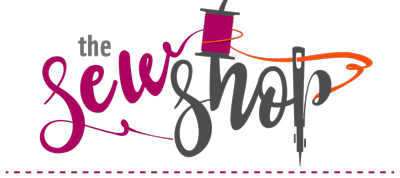Sewing Machine Buying Guide
Here are some tips for buying your sewing machine.
Features of the sewing machines
Even the basic models of sewing machine “should” be able to sew fabrics, from fabric to jeans, without making lengthenings, unwanted ruffles, loose or wrong stitches. We say 'should' because it's not always so.
A sewing machine with just one selection dial has basic sewing functions, whereas sewing machines with 3 or 3 selection dial have other functions as the chance to change the stitch length and width. It's good to orientate your purchase according to your necessity, leaving a margin for when you'll be more expert.
Here are some useful features that sewing machines can have.
Manageability: if you have to put your sewing machine in an armoir, you should buy a machine easy to pick up and carry, and it would be better with a built-in handle.
Perfect ergonomics: the sewing machine must react to the pressure made on the pedal making an harmonic move,not jerking; it ought not produce breaks or squeaks when thick fabrics or layers of fabric are sewed.
Controls: they must be easy to reach and use; the symbols shown on the machine must be immediately understandable.
Free harm and good structure of the base: when the accessories's compartment or the extendable surface are removed, the sewing machine switches from the orizontal seam modality to the free harm modality. The free harm modality is useful for making circular seams, for example hems of pants, sleeves or cuffs. Obviously a good metal structure assures duration and reliability.
Needle-threader: some sewing machines have an authomatic needle-threader tha allows to insert the upper thread in the needle.The needle-threader is useful if you have dificulties in seeing the needle eye and to accelerate the sewing time.
From-on-high loading of the bobbin: you have only to open the cover for inserting and removing the bobbin. You load it very easily and it's possible to control the quantity of thread in the bobbin thanks to the transparent cover. This system is called “rotary hook” with from-on-high loading.
Anterior loading of the bobbin: the bobbin is inserted in an appropriate capsule that is inserted in the hook compartment under the needle-plate. The anterior loading is reccomended for the embroidery with free move. There are 2 systems of anterior loading: the most common on the cheaper products is the “oscillating hook”, the more advanced is the “frontal rotary hook”.
Presser-foot: it keeps the fabric under the needle stretched, so it is carried without problems from the feed-dog and powered gradually during the sewing. There are different feet for the many phases of sewing, as the application of zips, execution of buttonhole, whipstitch.
Needle-plate: it is inserted over the feed-dog and avoids damages of the fabric in the sliding guide during the seam. There a hole in the plate that allows the transit of the needle in the sliding zone in order to make the stitch. On the needle-plate there can be references in cm or inches useful for guiding the seam.
Feed-dog: consists of multiple rows of teeth that protrude from the grids of the needle plate, the more advanced models have a system for the return of the feed dog, to facilitate the insertion of thicker fabrics or more delicate, such as velvet.
Supplyteeth:advance the fabric from the front to the back of the feed-dog.
Return of the feed-dog: some sewing sewing machines have a function that allows to lower the supply teeth and move manually the fabric backwards, forwards and sideways. This is a useful function when you make embroidering,or for monogramming or quilting and fastening buttons.
Control of presser-foot pressure: this function (only on more advanced models) allows you to adjust the pressure exerted on the fabric by the presser foot, keep in mind that highly elastic jersey item can not be sewn as a silk fabric.
Choosing Your Sewing Machine
It is good to consider the following points in the choice of a new Sewing machine;
- Intended use of the sewing machine.
Your budget.
Sewing set up and facility use
Facility in storing the sewing machine after the use
Availability of accessories and spare parts.
Product guarantee.
After sales service facilities.
Types of Sewing Machines
There are many different types of sewing machines available on the market today such as Computerised sewing machines, Electronic and Mechanical machines.
The Toyota Mechanical sewing machines are divided into 3 Ranges and are renowned for their ease of use and reliability;
a) Single Dial Sewing Machines:
They have a stitch selection dial with a stitch selection ranging from 15, 18 and 21 stitches including a 4 step automatic buttonhole.
These sewing machines are ideal for the novice as well as the occasional sewer.
b) 2 Dial Sewing Machines:
These sewing machines have a stitch selection dial and a stitch length control.
The stitch range varies from 21 to 24 stitch capabilities including a 4 step automatic buttonhole.
This range of sewing machines would suit the more creative or experienced sewer.
c) 3 Dial Sewing Machines:
3 dial sewing machines have a stitch selector, stitch length and stitch width controls. The stitch pattern range varies from 21 to 25 stitch capabilities including a 1 step automatic buttonhole.
These sewing machines would suit the more adventurous sewer and are ideal for free motion sewing and embroidery.
Some sewing machines have a rotary hook with a top loading bobbin such.
Sewing machines can also have an oscillating hook with a front loading bobbin.
Both these types of sewing machines produce a ‘Lock stitch’ and are ideal home sewing machines.
Since many years there are also computerised/electronic sewing machine. You don't need to move lever or selection buttons, you have only to select on the keyboard the number or the stitch you want to do and it's all ready.
The movement of the needle and of the feed-dogs are controlled by a board and can perform stitches that are impossible for a mechanical model. For example, think of the buttonholes or eyelets: while a mechanic sewing machine can realize only one type (rectangular one), the electronic models may realize teardrop eyelets, round, for elastic fabrics and many more. Then exist between the electronic sewing machines some models capable of loom embroidering practically on their own, almost without the intervention of a person. Just select the embroidery you have to realize from memory the machine with the color you want and you're ready. You only have to change the color of the yarn if the embroidery is multicolored. Unthinkable just a few years ago.
Overlock Buying Guide 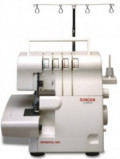 2-3-4 threads overlock
2-3-4 threads overlock
The first important thing to know, especially for beginners, is that the overlock is not a sewing machine and can not replace it, does not have the same functions but alongside the sewing machine it completes the ability to finish the work of sewing for the home in a professional manner, because with it you can make interior trim and even perfect external decorations. If only now started to sew and are planning a purchase the first thing to consider is a good sewing machine and the overlock, maybe to be added at a later date! But what exactly does? The use of the overlock is aimed primarily at clothes, sews and finishes at the same time cutting off the excess fabric, it works seamlessly with any type of fabric from lightest to heaviest, and especially with jersey, lycra used for costumes bathroom, and all stretch fabrics. Thanks to the specific feet, it can curl, apply elastic, beads and cord, rolled hems done in a moment, and more of each type of fabric. There are many models each of which offers different types of points and can sew with 2-3-4-5 wire, and 1 or 2 needles. 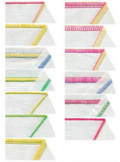 Overlock stitches
Overlock stitches
The overlock works with two hook and the needle threads itself in order to form a. The overlock hooks lead the threads forming the loops on the two sides of the cloth, so as to fix the raw edges. These threads are interwoven with the needle thread to form a stitch. For the whipstitch with 2 or 3 wires, use 1 needle; for whipstitch with 4 threads, use 2 needles. There are also models which can realize the '5 security threads 5' finishing, 2 of which are used to form a straight seam called chain stitch and 3 to finish the edge of the fabric. This stitch is widely used in industry for the manufacture of work clothes, jeans and where we need a very strong combined with finishing seam. 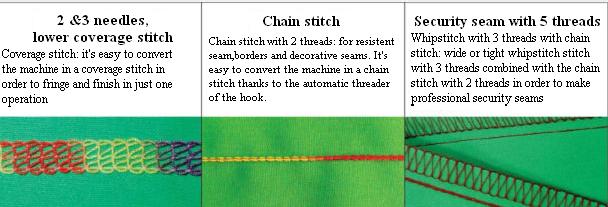
A particular type of overlock is the one which allows more than the normal cutting and sewing, also the realization of the coverage stitch or 'cover stitch'.
These models are particularly indicated for advanced sewing or who want to avoid the purchase of 2 different machines, integrating in a single product an advanced overlock and a cover stitch able to perform at least four different types of stitch. The colored paths help in the threading
The colored paths help in the threading
Each thread has a specific tension command, in order to allow to adjust the tension of the threads and sew on any type of fabric.
The differential transport is now mandatory on these machines, given that the majority of fabric is synthetic and elasticized to prevent wrinkles and curls, as well as the regulation of the stitch length and width of the cut for a perfect result of any material, as well as of the colored paths for an easier threading.
There are still machines that perform only the coverage stitches with 2 or 3 needles and the chain stitch, which we recommend to seamstresses and small laboratories who want a machine that is always ready for making perfect edges on fuseau, underwear, polo shirts, t shirt and so on. 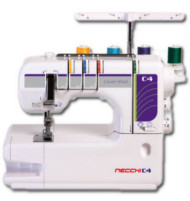 Coverstitch machine
Coverstitch machine
Hoping that this article there may have been of help, please do not hesitate to contact us without any obligation for any doubts, questions or more specific information.
If you would like more detailed information you can visit our website www.sewshop.eu or contact us at: info@sewshop.eu
